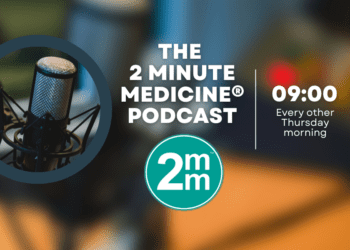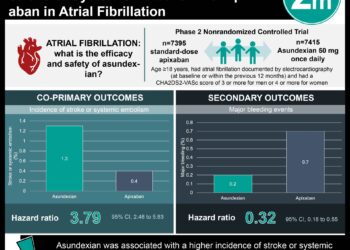#VisualAbstract: Rivaroxaban noninferior to warfarin in patients with atrial fibrillation and bioprosthetic mitral valves
1. Patients who received rivaroxaban had a statistically significantly longer mean time until occurrence of a major clinical event compared to those who received warfarin.
2. The incidence of secondary-outcome events such as transient ischemic attack (TIA), valve thrombosis, and non-CNS embolism were similar between groups.
Evidence Rating Level: 1 (Excellent)
Study Rundown: Atrial fibrillation is associated with an elevated risk of thromboembolic events that is dramatically exacerbated by the presence of valvular heart disease (VHD). Prophylactic anticoagulant therapy is essential for these individuals, but current recommendations are not easily applicable to this patient population due to their exclusion from participation in several pivotal direct oral anticoagulant (DOAC) versus warfarin trials (i.e. Re-LY, AVERROES, ROCKET-AF). To address this insufficiency of direct evidence, this study specifically investigated the prophylactic effect of rivaroxaban in patients with both atrial fibrillation and a bioprosthetic mitral valve, finding that those who received the DOAC had a significantly longer mean time until a major clinical event compared to those who received warfarin. This effect was consistent across most subgroups, but it was pronounced among patients who were enrolled within 3 months of mitral-valve surgery. In the component breakdown, those who received rivaroxaban had a numerically higher, but not statistically significant, incidence of valve thrombosis versus warfarin at 1 year and a lower incidence of other secondary outcomes such as stroke and death from cardiovascular causes or thromboembolic events. The total number of bleeding events was similar between the two groups, but individual events were generally of lesser severity among those who received rivaroxaban. While these findings cannot be generalized to patients with other types of valvular heart disease, they suggest that rivaroxaban is noninferior to warfarin for thromboembolism prophylaxis in patients with both atrial fibrillation and a bioprosthetic mitral valve.
Click here to read the study in NEJM
Relevant Reading: Usefulness and Safety of Rivaroxaban in Patients Following Isolated Mitral Valve Replacement With a Mechanical Prosthesis
In-Depth [randomized controlled trial]: In this multicenter study conducted in Brazil from April 2016 through July 2019, 1005 adults who had atrial fibrillation or flutter and a mitral valve prosthesis and were taking or planning on taking oral anticoagulants for thromboembolism prophylaxis were randomly assigned in a 1:1 ratio to receive either rivaroxaban or warfarin. Rivaroxaban was administered at a dosage of 20 mg per day with the exception of patients with a creatinine clearance of 30-49 mL per minute per 1.73 m2 of body-surface area, who instead received 15 mg per day; warfarin dosage was adjusted at least every 4 weeks to maintain a target international normalized ratio (INR) of 2.0 to 3.0. The primary outcome was a composite of death, major bleeding, and major cardiovascular events (stroke, TIA, valve thrombosis, systemic embolism unrelated to the central nervous system, or hospitalization for heart failure). The mean time until any of these events was slightly higher in the rivaroxaban group compared to warfarin (347.5 days vs. 340.1 days; restricted mean survival time difference, 7.4 days; 95% CI, −1.4 to 16.3; P<0.001 for noninferiority and P=0.10 for superiority). Of the individual components of the composite outcome, valve thrombosis was numerically more frequent in the rivaroxaban group (5 vs. 3), while death from cardiovascular causes or thromboembolic events was slightly more frequent in the warfarin group (3.4% vs 5.1%; hazard ratio [HR], 0.65; 95% CI, 0.35 to 1.20). With the exception of stroke (0.6% vs. 2.4%; HR, 0.25; 95% CI, 0.07 to 0.88), other secondary outcomes were similar between groups at 12 months. Serious adverse events (5.8% vs. 6.9%) and total bleeding events (HR, 0.83; 95% CI, 0.59–1.15) occurred at similar rates in both groups, although the warfarin group had a numerically greater number of major, intracranial, and fatal bleeding incidents.
Image: PD
©2020 2 Minute Medicine, Inc. All rights reserved. No works may be reproduced without expressed written consent from 2 Minute Medicine, Inc. Inquire about licensing here. No article should be construed as medical advice and is not intended as such by the authors or by 2 Minute Medicine, Inc.







